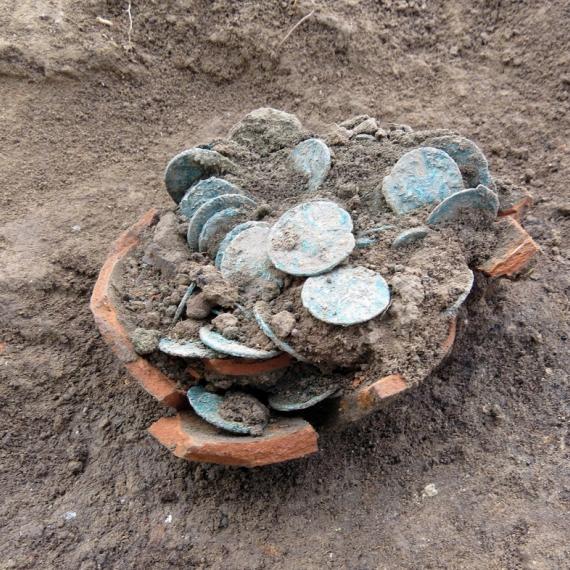Archaeological excavations
Archaeological digs form an integral part of teaching and research activities of some University departments. They provide opportunities to meet and discuss with researchers from national and international institutions.
Field training also includes other planned and emergency excavation initiatives, in Italy and abroad, led by archaeology superintendencies, other universities, civic museums or other research centres.
Italian students often work with students from foreign universities who participate in Erasmus and other exchange programmes, or with students from the country where the excavation takes place.
Excavations and research are funded by ad-hoc funds made available by the University of Milan, as well as by the Ministry of Cultural Heritage, the Ministry of Education, University and Research through FIRB (Fund for investment in basic research) and PRIN (Projects of national interest) funding, and the Ministry of Foreign Affairs.

The excavation projects of the Department of Cultural and Environmental Heritage range from prehistory and protohistory to the Roman period.
Excavation campaigns have been conducted for decades in the following sites (by chronological phase):
- Lavagnone (Desenzano del Garda, BS)
pile dwellings from the Early and Middle Bronze Age, UNESCO world heritage site since 2011
- Forcello di Bagnolo San Vito (MN)
Etruscan-Po Valley emporium settlement north of the Po
- Calvatone-Bedriacum (CR)
Roman settlement, the scene of famous battles in 69 AD
Research activities carried out in Lombardy by the Department of Earth Sciences include archaeological and paleontological excavations and preventive archaeology interventions, ranging from prehistory to protohistory up to the classical era in the localities of:
- Monte Generoso (CO)
- Ticengo (CR)
- Val Chiavenna (SO)
The archaeological excavations conducted in Italy by the Department of Cultural and Environmental Heritage range from prehistory and protohistory to the Etruscan, Greek, and Punic period, up to the Roman occupation. Excavations have been conducted for decades in the following sites (by chronological phase):
- Colombare di Negrar di Valpolicella (VR)
Neolithic and Eneolithic settlement - Monte Zara in Monastir (CA)
nuragic settlement; Italic civilisation - Tarquinia (VT)
urban area on the Civita plateau; Etruscan civilisation - Selinunte (TP), in collaboration with New York University
acropolis, temple R; Siceliot civilisation - Jazzo Fornasiello, in Gravina in Puglia (BA)
Peucetian settlement on the borders between the Greek territories of Metaponto and Taranto, Magna Graecia and Italic civilisation - Nora (CA)
"Central District", Punic and Roman civilisation - Sperlonga, Villa della Grotta (LT)
magnificent Roman imperial villa
The archaeological excavations, reconnaissance and preventive archaeology interventions of the Department of Earth Sciences in Italy range from prehistoric to protohistoric phases, especially in the Emilia area. In this context, the department has been coordinating the Poviglio excavation project for 36 years.
Moreover, collaborations are underway on excavation sites of primary importance throughout Italy:
- Terramara Santa Rosa di Poviglio (RE)
- San Michele di Valestra a Carpineti (RE)
- Sant’Andrea di Travo (PC)
- Votive pool of Noceto La Torretta (PR)
- Balzi Rossi, Riparo Bombrini in Ventimiglia, in collaboration with the University of Genoa
- Uluzzo C cave, in Nardò (LC), in collaboration with the universities of Bologna and Rome "La Sapienza".
International research projects of the Cultural and Environmental Heritage Department include important excavation sites in the Mediterranean, as well as in the Near East:
- "Thermal Baths South of the Praetorium" in Gortyna, Crete, in collaboration with the Italian School of Archaeology in Athens
; Late Roman and Byzantine civilisations - Pal.MAIS dig, "South-West District" in Palmira, Syria - closed project
Roman, Late Roman and Byzantine civilisations
The Department of Earth Sciences has been collaborating for nearly thirty years with various national and international institutions in major excavation projects in Africa, the Near East, the Arabian Peninsula.
- Africa
- Al-Jamrab, Khartoum, Sudan
- Al Khiday, Khartoum, Sudan, in collaboration with CSSeS, the Sudanese Study Centre
, and with La Sapienza University - Wadi Lezalim, Tunisia,
- Gotera and Yabelo, Ethiopia
- Lake Turkana, Kenya
- Near East
- Dohuk Region, Iraqi Kurdistan, in collaboration with the University of Udine
- Jebel Qara, Sultanate of Oman, Arabian Peninsula, in collaboration with INRAP, Institut national de recherches archéologiques, France.
-
Funded by funds from the University and the Ministry of Foreign Affairs and Cooperation, the archaeological digs of the Department of Literary Studies, Philology and Linguistics span from Egypt to Kurdistan:
- Aswan, Aga Khan necropolis, Egypt - EIMAWA, Egyptian-Italian Mission at West Aswan.
- Tebtynis - Umm-el-Breigat, Egypt
- Erbil, Helawa/Aliawa, Iraqi Kurdistan
- Kultepe-Kanesh, Turkey.

